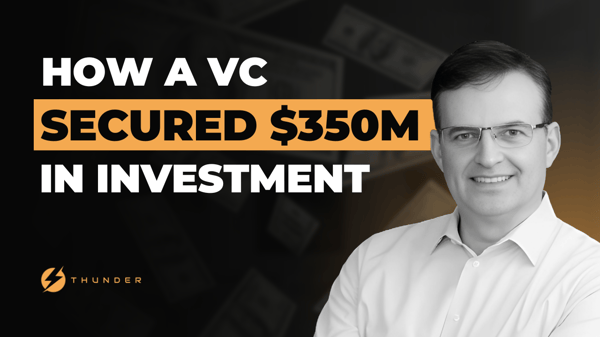What's Below in Issue #68:
📰 - A look into determining how much funding you should raise
📊 - Data behind Pre-Seed deals retaining funding levels
🎙️- Podcast w/ Proof.vc Managing Director, Thanasis
💵- Premium startup resources
🆓- Free startup resources
-------------------------------------------------------------------------------------------------------------------------------------------------------------
Have revenue and need access to quick capital?
The cost of equity capital is getting expensive; debt or working capital might be a better option if you're already generating revenue, and it's non-dilutive.
We've made it easier than ever to get matched with private capital providers and receive offers in minutes, not weeks or months.
*We don't charge any fees to source you debt*
------------------------------------------------------------------------------------------------------------------------------------------------------------
The Magic Funding Number
Who wants LOTS of money? I don’t. I want just enough.
If you are a founder of an early-stage startup, one of the most important decisions you have to make is how much money to raise. It may seem like a simple question, but it is not. At Thunder, we help founders answer that question every day. There is a specific sweet spot for how much to raise. Raising too much or too little can have serious consequences for your startup’s success and survival.
What if I Raise Too Much Money?
You may think that raising more money is always better. After all, having more money means having more resources, more opportunities, and more security. However, raising too much money can also have some negative effects, such as:
- Diluting your ownership and control. Fundraising is not a grant - it’s a sale. You get money in exchange for equity. When you raise a lot of money, you have to give up a significant portion of your equity and often board seats to your investors. This means that you have less say in the strategic direction of your company and more pressure to meet their expectations. You may also face more competition from other well-funded startups or incumbents who see your large funding as a threat or an opportunity.
- Losing discipline and focus. It is easy to assume money won’t affect how you run your company, but it affects everyone. When you get a massive check that can keep you floating for a long time, you may lose the sense of urgency and the lean mindset that are essential for startups. You may start spending money on things that are not critical for your growth, such as hiring too many people, launching too many features, or expanding too fast. You may also lose sight of your core value proposition and your product-market fit, and become distracted by shiny objects or vanity metrics.
- Raising the bar for your exit. When you raise a lot of money, you also raise the expectations for your future performance and valuation. You have to grow faster and bigger to justify your funding and provide a satisfactory return to your investors. This may limit your options for exiting, as you may not be able to find a buyer or go public at the price you want or need.
- Harder to win as a founder. When investors have aggressive liquidation preferences, it makes getting a good payday at the end of the process much harder. If you raise lots of money, your investors will be entitled to much more in the exit, making the needed exit valuation much higher to give yourself any type of financial return. There are many stories of founders who built incredible businesses and exited, only to be left with nothing due to investor liquidation preferences.
What if I Raise Too Little Money?
So we scared you and now you may think that raising less money is safer or smarter. You may want to preserve your ownership and control or avoid the hassle and distraction of fundraising. However, raising too little money can also have some negative effects, such as:
- Running out of money before you achieve product-market fit. Without question, this is the greatest risk you face. When you raise too little money, you may not have enough resources to build, test, and iterate on your product until you find a fit with your target market. You may also not have enough money to hire the right talent, acquire customers, or scale your operations. You may end up running out of cash before you can prove your traction and viability to your investors or potential acquirers.
- Unable to fundraise your next round. If you can’t hit the needed KPIs before the end of your runway, it will be extremely difficult to fundraise. Investors are expecting you to achieve what you promised with the money you raised. It was your responsibility to determine how much you needed. It is very sad when companies are forced to close because they under-raised their last round and are not able to achieve what they need for more capital.
- Compromising your vision. When you raise too little money, you may have to make trade-offs that go against your vision. You may have to pivot to a different market, product, or business model that is more profitable but less impactful. This is often because you see that more VC money is not possible and have to choose between profitability or going under.
How Much Should I Raise?
So, how can you avoid the pitfalls of raising too much or too little money, and find the optimal amount of funding for your startup? Here are some tips to help you:
- Define your next milestone. Your next milestone should be something that validates your assumptions, demonstrates your progress, and increases your value. For example, it could be launching your MVP, acquiring your first 100 customers, or generating your first $1M in revenue. Your next milestone should also be realistic, measurable, and achievable within a reasonable timeframe.
- Estimate your runway. Your runway is the amount of time you have before you run out of money. You can calculate your runway by dividing your current cash balance by your monthly burn rate (the amount of money you spend each month). You should aim for a runway of at least 18 to 24 months, depending on your stage and risk tolerance.
- Add some buffer. Your runway is based on your assumptions and projections, which may not always be accurate or reliable. You may encounter unexpected challenges, delays, or changes in your market or industry. You may also need more time or money to achieve your next milestone than you anticipated. Therefore, you should add some buffer to your runway, such as 20% to 35%, to account for these uncertainties and contingencies.
- Raise enough money to reach your next milestone plus buffer. This is the optimal amount of funding for your startup. It gives you enough resources and flexibility to execute your vision, but not so much that you lose your discipline, ownership, or exit options. It also allows you to raise money from the right investors who share your vision, values, and expectations, and who can provide you with more than just capital, such as mentorship, network, or expertise.
Relevant Articles for Pitching to Journalists
- How much money should you raise for your startup? - 👉 TechCrunch
- How To Determine The Amount To Raise In Your Round - 👉 Forbes
- You’re Not Raising Enough Startup Funding - 👉 Medium
-------------------------------------------------------------------------------------------------------------------------------------------------------------Data Corner
.png?width=600&height=337&name=unnamed%20(4).png)
Great News for Early-Stage Founders
We've been showing data on how the VC market is shrinking, but that seems to be mainly for Seed and above. If you are a pre-seed founder (many of our readers), then your fundraising prospects still look good. This does not mean that it will be as easy as it was in 2021 or that the discussions are still happening quickly. It will still be a difficult push - but you can do it!
-------------------------------------------------------------------------------------------------------------------------------------------------------------Fundraising Demystified Episode #36 is Live! Thanasis Reveals His Strategies for Managing a $350M Fund Serving Early-Stage VCs

In this episode, we are joined by Thanasis Delistathis, managing partner and co-founder of Proof, to talk about their groundbreaking insider access strategy in venture capital. Proof partners with early-stage funds to invest in high-potential breakout companies, boasting a track record of success, including the recent acquisition of Jackpocket. With investments totaling approximately $350 million on behalf of Limited Partners (LPs) through managed entities, Proof leads the way in innovative fund management.
Thanasis discusses the origin of the opportunity fund and how it evolved into the Proof strategy. He emphasizes building relationships with early-stage funds and Proof's role in facilitating co-investments while explaining the strategy's economic incentives and addressing fundraising challenges and opportunities. Venture capitalists and fund managers won't want to miss these insights into navigating the competitive landscape and unlocking investment opportunities.
-------------------------------------------------------------------------------------------------------------------------------------------------------------
Free Fundraising Resources
🤓 - Free pitch deck reviews - Submit your deck
💸 - Access working capital fast - Explore options for free
😍 - Free list of AI Recommended VCs - Apply for free
👨💻 - Free fundraising coaching session - Schedule 15 minutes with us
📝 - Playbook for Negotiating Term Sheets - Download it Here
💽 - Playbook for Setting Up and Sharing Your Data Room - Download it Here
✉️ - Playbook for Sending Investing Updates - Download it Here
Premium Resources
Your pitch deck built by VCs and designers
🗓️ - Book a one-hour private capital strategy call - Book Now
💫 - Pitch deck design services for founders by VCs - Decko
💼 - Startup Legal Services - Bowery Legal
📚 - Startup Friendly Accounting Services - Chelsea Capital
Download Your List of Targeted Investors:
- Access to VC firms' team tabs to see active partners of the fund & their LinkedIn
-
Navigate a VC's portfolio to see relevant portcos or competitors, quickly find their founders on LinkedIn to connect with them, and request warm introsA downloadable CSV with the investor emails & LinkedIn URLs
- Ability to filter your matches and adjust your profile
-
LiteCRM to track your progress
-
Request intros to VCs directly through the platform
- Get our fundraising guide on how to increase your odds of getting a meeting
- Upgrade to lifetime access (one-time fee of $497) and get a free coaching session
Upgrade Now for $59/month
-------------------------------------------------------------------------------------------------------------------------------------------------------------
Let's stay in touch:
- Written by Jason Kirby - https://www.linkedin.com/in/jasonrkirby
- Subscribe to our weekly newsletter for market and industry news and tips when it comes to raising capital and growing your business - https://join.thunder.vc
- Seeking to raise capital? Get your list of target VCs by creating a free profile here - https://web.thunder.vc
- Looking to raise debt? Explore tailored debt options for free by completing a profile at https://debt.thunder.vc



